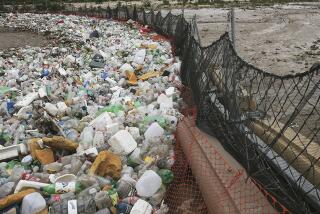Reduced Sewage Treatment Would Be Step Backward for Public Health
- Share via
Coastal and inland communities for years have been releasing their sewage into the ocean. The source may be household waste, industrial waste or even hospital waste. The dumping areas handle tens of millions of gallons every day.
Because of widespread concern over this problem, Congress enacted the Clean Water Act of 1972, requiring full “secondary” treatment of such sewage.
Previous treatment was a “primary” process. Waste water was placed in a collection tank, and whatever settled out or floated to the top was removed after a short retention period; the balance was flushed into the ocean. This had little effect on the viruses, bacteria, toxic compounds and pesticides.
With secondary treatment, most of the bacteria and viruses are eliminated, less suspended solids are released into the ocean and much of the toxic compounds are removed.
In the late 1970s, Western states asked Congress to relax the clean-water standards, arguing that less treatment added nutrients to the ocean. Their efforts were successful, and Congress allowed agencies to apply for permission to use “advanced primary” treatment, generally a combination of secondary and primary.
Oceanside recently withdrew its application for a waiver from the secondary-treatment standard. A waiver granted to Escondido and the county is being appealed, and San Diego is waiting to hear on its application.
Sewage officials and their consultants argue that advanced primary treatment is sufficient. They claim that risk to public health is remote because the effluent is dumped far enough offshore and under a density layer that acts as a barrier and cleanser. They contend that the required monitoring will show any deviance and that the “safe” state standards still must be met.
Concerned residents, scientists and medical professionals argue that advanced primary treatment is not enough. (Jacques Yves Cousteau has stated that nothing less than secondary treatment is acceptable for California coastal waters.)
Marine biologists and oceanographers argue that the state’s monitoring standard is not acceptable because this allows ocean water to be contaminated up to 20% of the time in a 30-day period. They also argue that upwelling and internal waves can bring the sewage to shore. Whereas ocean water may affect some bacteria, viruses and toxins are not sufficiently eliminated.
It is documented through numerous scientific studies that:
- Human feces can contain more than 110 types of intestinal viruses.
- Swimming in water contaminated by sewage can cause illness among ocean users.
- As little as one viral particle can cause an infection.
- Reduced treatment poses much greater risk of viral infection than full secondary treatment.
- Viruses can survive in ocean water for weeks (or months in some cases).
- The state testing procedure won’t detect viruses in the water, and therefore, at times the water will test safe when it is not.
- Suspended solids in the ocean will be at least twice as much in advanced primary treatment as in secondary treatment.
City councils whose cities have secondary treatment, report there will be no decrease in sewage bills if downgrading occurs. An increase in rates for existing secondary treatment makes one question who will enjoy the financial benefits while public health is at risk.
To reduce the amount of treatment as our population is steadily increasing is a step backward for sound public-health policy.
More to Read
Sign up for Essential California
The most important California stories and recommendations in your inbox every morning.
You may occasionally receive promotional content from the Los Angeles Times.













